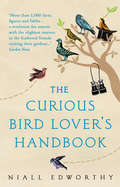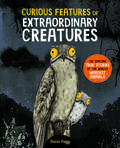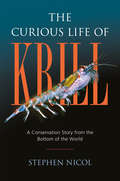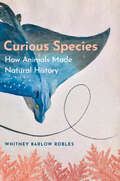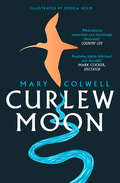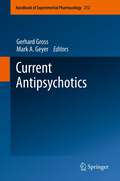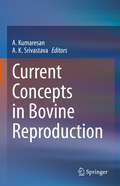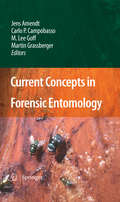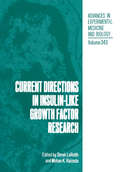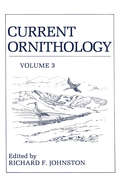- Table View
- List View
Curiosity and Exploration
by BruceHenderson KlausSchneider HeidiKellerExploration and play behaviour form the subject of this book, in which a wide range of research activities, both theoretical and practical, are presented from various fields. In particular, the emphasis on applications (for example, in the development of software) demonstrates the integrated approach to basic and applied research. The authors come from many different countries and represent various theoretical approaches, enabling the reader to acquire an up-to-date overview of the field and thus form an opinion of his/her own regarding this field of research.
The Curious Bird Lover’s Handbook
by Niall EdworthyYou don't have to be a dedicated birdwatcher to be a bird lover. Millions of us love the sight and sound of them. And yet most of us know very little about their remarkable behaviour, incredible diversity and the story of their evolution. How do migrating birds know where to go?Are birds really descended from dinosaurs?How do birds have sex?This handbook sets about answering every interesting question there is to ask about birds. There are over 10,000 species in the world, including over 500 in Britain, some rare and endangered, some bizarre and beautiful, others common and familiar. As this captivating and often humorous handbook reveals, all of them are fascinating.The hardback edition titled "Bald Coot and Screaming Loon" was published in 2009. This paperback edition has been updated and includes a new foreword from the author.
The Curious Book of Lists: 263 Fun, Fascinating and Fact-Filled Lists (Curious Lists)
by Tracey TurnerDo you want to know about eight of the world’s deadliest snakes, forty-nine countries without a coastline and five fearless female warriors?Then look no further because The Curious Book of Lists by Tracey Turner is absolutely bursting with eye-popping and informative lists from around the world, guaranteed to keep you entertained and increase your general knowledge at the same time! Discover Ancient Greek monsters, presidential pets, dizzying mountain peaks, super-fast animals … and what not to mention at a donkey’s house.With quirky, colourful illustrations by Caroline Selmes, this is a great gift purchase but also a book to buy for yourself!
A Curious Boy: The Making Of A Scientist
by Richard ForteyWhat makes a scientist? In a charming memoir, beloved and brilliant scientist Richard Fortey offers a tour of the natural world in all its joys, puzzles and curiosities.
Curious Features Of Extraordinary Creatures
by Camilla de BedoyereMeet incredible creatures from all around the world in this colourful, fact-packed animal guide.Curious Features of Extraordinary Creatures tells you all the essential facts about some of the most unique mammals, birds, fish, reptiles and insects that can be found on our planet. Bite-sized text breaks down key information about the creature’s appearance, behaviour and habitat, while colourful and dynamic illustrations bring the animal to life in front of you. Each spread also features bold graphic-novel style panels that tell the story of a key aspect of each animal’s daily life, such as the aye-aye foraging for its dinner and the peacock spider performing a dramatic dance to attract a mate.
The Curious Life of Krill: A Conservation Story From The Bottom Of The World
by Stephen NicolKrill-it’s a familiar word that conjures oceans, whales, and swimming crustaceans. Scientists say they are one of most abundant animals on the planet. But when pressed, few people can accurately describe krill or explain their ecological importance. Antarctic krill have used their extraordinary adaptive skills to survive and thrive for millions of years in a dark, icy world far from human interference. But with climate change melting ice caps at the top and bottom of the world, and increased human activity and pollution, their evolutionary flexibility to withstand these new pressures may not be enough.Eminent krill scientist Stephen Nicol wants us to know more about this enigmatic creature of the sea. He argues that it’s critical to understand krill’s complex biology in order to protect them as the krill fishing industry expands. This account of Antarctic krill-one of the largest of eighty-five krill species-takes us to the Southern Ocean to learn firsthand the difficulties and rewards of studying krill in its habitat. Nicol lays to rest the notion that krill are simply microscopic, shrimplike whale food but are in fact midway up the food chain, consumers of phytoplankton and themselves consumed by whales, seals, and penguins. From his early education about the sex lives of krill in the Bay of Fundy to a krill tattoo gone awry, Nicol uses humor and personal stories to bring the biology and beauty of krill alive. In the final chapters, he examines the possibility of an increasingly ice-free Southern Ocean and what that means for the fate of krill-and us.Ocean enthusiasts will come away with a newfound appreciation for the complex ecology of a species we have much to learn from, and many reasons to protect.
Curious Questions From Adam’s Farm: Discover over 40 fascinating farm facts from the UK’s beloved farmer
by Adam HensonDiscover even MORE farm facts from the UK’s favourite farmer!Answering over 40 questions from children just like you, Adam will show you what it’s like to really work on a farm. Questions like:How are sheepdogs trained?How do farms grow things like breakfast cereal and birthday cakeCan cows ACTUALLY predict when it’s going to rain?From Countryfile presenter, Adam Henson, Curious Questions From Adam's Farm is a jam-packed fact book for tractor-obsessed, animal-loving toddlers and young readers.Breaking down everything from farm equipment to animal friendships, it’s the perfect gift for any child who wants to know more about life on a farm.
Curious Species: How Animals Made Natural History
by Whitney Barlow RoblesA compelling and innovative exploration of how animals shaped the field of natural history and its ecological afterlives Can corals build worlds? Do rattlesnakes enchant? What is a raccoon, and what might it know? Animals and the questions they raised thwarted human efforts to master nature during the so-called Enlightenment—a historical moment when rigid classification pervaded the study of natural history, people traded in people, and imperial avarice wrapped its tentacles around the globe. Whitney Barlow Robles makes animals the unruly protagonists of eighteenth-century science through journeys to four spaces and ecological zones: the ocean, the underground, the curiosity cabinet, and the field. Her forays reveal a forgotten lineage of empirical inquiry, one that forced researchers to embrace uncertainty. This tumultuous era in the history of human-animal encounters still haunts modern biologists and ecologists as they struggle to fathom animals today. In an eclectic fusion of history and nature writing, Robles alternates between careful historical investigations and probing personal narratives. These excavations of the past and present of distinct nonhuman creatures reveal the animal foundations of human knowledge and show why tackling our current environmental crisis first requires looking back in time.
Curlew (Large Print)
This is a Curlew shown from the side with its head facing to the left. There is a locator dot shown, which will be at the top left of the page when the image is the right way up. At the far left of the picture is the Curlew's long, downward-curving beak. To the right of this is its head, with one eye showing. Further to the right is the Curlew's body with one wing visible. Down the page from this are its very long legs. Its plumage is mainly grey-brown.
Curlew Moon
by Mary Colwell‘Focuses a razor light on the plight of one of our most iconic birds. Inspirational!’ Tim Birkhead Curlews are Britain’s largest wading bird, known for their evocative calls which embody wild places; they provoke a range of emotions that many have expressed in poetry, art and music.
Curlew (UEB Contracted)
This is a Curlew shown from the side with its head facing to the left. There is a locator dot shown, which will be at the top left of the page when the image is the right way up. At the far left of the picture is the Curlew's long, downward-curving beak. To the right of this is its head, with one eye showing. Further to the right is the Curlew's body with one wing visible. Down the page from this are its very long legs. Its plumage is mainly grey-brown.
Curlew (UEB Uncontracted)
This is a Curlew shown from the side with its head facing to the left. There is a locator dot shown, which will be at the top left of the page when the image is the right way up. At the far left of the picture is the Curlew's long, downward-curving beak. To the right of this is its head, with one eye showing. Further to the right is the Curlew's body with one wing visible. Down the page from this are its very long legs. Its plumage is mainly grey-brown.
Current and Future Reproductive Technologies and World Food Production (Advances in Experimental Medicine and Biology #752)
by G. Cliff Lamb Nicolas DiLorenzoThis book addresses the impacts of current and future reproductive technologies on our world food production and provides a significant contribution to the importance of research in the area of reproductive physiology that has never been compiled before. It would provide a unique opportunity to separate the impacts of how reproductive technologies have affected different species and their contributions to food production. Lastly, no publication has been compiled that demonstrates the relationship between developments in reproductive management tools and food production that may be used a reference for scientists in addressing future research areas. During the past 50 years assisted reproductive technologies have been developed and refined to increase the number and quality of offspring from genetically superior farm animal livestock species. Artificial insemination (AI), estrous synchronization and fixed-time AI, semen and embryo cryopreservation, multiple ovulation and embryo transfer (MOET), in vitro fertilization, sex determination of sperm or embryos, and nuclear transfer are technologies that are used to enhance the production efficiency of livestock species.
Current Antipsychotics (Handbook of Experimental Pharmacology #212)
by Gerhard Gross and Mark A. GeyerSix decades after the serendipitous discovery of chlorpromazine as an antipsychotic and four decades after the launch of clozapine, the first atypical or second generation antipsychotic, psychopharmacology has arrived at an important crossroad. It is clear that pharmacological research and pharmaceutical development must now focus on complementary or even alternative mechanisms of action to address unmet medical needs, i.e. poorly treated domains of schizophrenia, improved acceptance by patients, better adherence to medication, safety in psychoses in demented patients, and avoiding cardiac and metabolic adverse effects. The first completely novel mechanisms evolving from our insights into the pathophysiology of psychotic disorders, especially the role of glutamatergic mechanisms in schizophrenia, are now under development, and further principles are on the horizon. This situation, in many respects similar to that when the initial second-generation antipsychotics became available, can be rewarding for all. Preclinical and clinical researchers now have the opportunity to confirm their hypotheses and the pharmaceutical industry may be able to develop really novel classes of therapeutics. When we were approached by the publishers of the Handbook of Experimental Pharmacology to prepare a new volume on antipsychotics, our intention was to capture both, the accumulated preclinical and clinical knowledge about current antipsychotics as well as prospects for new and potentially more specific antischizophrenia principles. These efforts should be based on the pathophysiology of the diseases and the affected neurotransmitter systems. Since preclinical research on antipsychotic compounds is only reliable when intimately linked through translational aspects to clinical results, we decided to include clinical science as well. It turned out that that this endeavor could not be covered by a single volume. We thank the editorial board and the publishers for supporting our decision to prepare two volumes: Current Antipsychotics and Novel Antischizophrenia Treatments. These topics cannot really be separated from one another and should be seen as a composite entity despite the somewhat arbitrary separation of contributions into two volumes. The continuing challenges of developing improved and safer antipsychotic medications remain of concern and are discussed in the first volume. The new opportunities for the field to develop and license adjunctive treatments for the negative symptoms and cognitive deficits that are treated inadequately by existing compounds have been incentivized recently and provide the focus for the second volume. We hope these collective contributions will facilitate the development of improved treatments for the full range of symptomatology seen in the group of schizophrenias and other major psychotic disorders.Gerhard Gross, Ludwigshafen, GermanyMark A. Geyer, La Jolla, CAThis volume will try to put current therapy - achievements, shortcomings, remaining medical needs - and emerging new targets into the context of increasing knowledge regarding the genetic and neurodevelopmental contributions to the pathophysiology of schizophrenia. Some of the chapters will also deal with respective experimental and clinical methodology, biomarkers, and translational aspects of drug development. Non-schizophrenia indications will be covered to some extent, but not exhaustively.
Current Concepts in Bovine Reproduction
by A. Kumaresan A. K. SrivastavaThis book provides updated information on the current concepts in bovine reproduction. It describes the complex issues associated with fertility and infertility in bovines and suggests strategies for achieving high reproductive efficiency. It discusses topics related to the fertility trend in bovines, estrus detection, controlled breeding, postpartum uterine health, uterine infections, and its therapeutic management. The essential roles of metabolic hormones on gonadal functions and fertility are also covered. Additionally, the book presents new insights in maternal recognition of pregnancy in bovines and suggest nutritional strategies to improve reproductive efficiency. The chapters on male fertility provide current information on semen cryopreservation, sperm quality assessment and measures to improve sperm fertility. A special chapter on intricacies in buffalo semen cryopreservation and measures to improve the quality of cryopreserved sperm is also included in this book. Lastly, the book introduces the immunobiological roles of anti-microbial peptides during sperm transport in reproductive tract and epigenetic bearing on fertility. This book is an invaluable resource for veterinary scientists, students and practitioners to understand the current developments in bovine reproduction for improving reproductive efficiency.
Current Concepts in Forensic Entomology
by Jens Amendt M. Lee Goff Carlo P. Campobasso Martin GrassbergerForensic Entomology deals with the use of insects and other arthropods in medico legal investigations. We are sure that many people know this or a similar definition, maybe even already read a scientific or popular book dealing with this topic. So, do we really need another book on Forensic Entomology? The answer is 13, 29, 31, 38, and 61. These are not some golden bingo numbers, but an excerpt of the increasing amount of annual publications in the current decade dealing with Forensic Entomology. Comparing them with 89 articles which were published d- ing the 1990s it illustrates the growing interest in this very special intersection of Forensic Science and Entomology and clearly underlines the statement: Yes, we need this book because Forensic Entomology is on the move with so many new things happening every year. One of the most attractive features of Forensic Entomology is that it is multid- ciplinary. There is almost no branch in natural science which cannot find its field of activity here. The chapters included in this book highlight this variety of researches and would like to give the impetus for future work, improving the dev- opment of Forensic Entomology, which is clearly needed by the scientific com- nity. On its way to the courtrooms of the world this discipline needs a sound and serious scientific background to receive the acceptance it deserves.
Current Concepts in Medical Research and Practice (Advances in Experimental Medicine and Biology #1039)
by Mieczyslaw PokorskiChange is an inherent feature of all aspects of clinical practice and patient management. This book seeks to contribute to presenting novel knowledge in various fields of clinical work. The articles tackle transdisciplinary topics and focus on the underlying mechanisms of clinical disorders, their prevention and management. The themes addressed include allergy and pseudoallergy in the pediatric population, influenza-related infections and their sequelae, which continues to be a scourge in the developing world, the risk of lung cancer repeats and their management, viral hepatitis that may lead to hepatocarcinoma, respiratory consequences of diaphragmatic hernias, disorders of steroid hormone metabolism, and others. The articles bring the updated strategies, research, and best practices to improve outcomes and to deliver state-of-the-art clinical care to patients. The book will be of interest to physicians, academic scientists, and researchers who are keen in sharing the latest medical practice developments.
Current Directions in Insulin-Like Growth Factor Research (Advances in Experimental Medicine and Biology #343)
by Mohan K. Raizada DerekRoithThe study of the insulin-like growth factor (IGF) family has become an exciting area of investigation. Initially, this family consisted of ligands (insulin, IGF-I and IGF-m and receptors (the insulin receptor, the type I or IGF-I receptor and the type II or IGF-IYM-6-P receptor). Subsequently, it was discovered that six specific binding proteips (lGFBPs 1-6) playa major role in the actions of this growth factor family. In addition, there are now more potential receptors when one considers the possible roles of the insulin-receptor related receptor (IRR) and hybrid receptor dimers composed of insulin and IGF-I receptor (half-receptors). Another important aspect of this area of research is the realization that the IGFs are not only essential for normal growth and development but, in addition play an important role in the normal specialized function(s) of all tissues of the body, including the nervous system, skeleton, reproductive system, kidney, and the immune system, to name but a few. The development of recombi!tant human IGF-I for clinical testing has been a major breakthrough for investigators. Potential uses include wound healing, reversal of catabolic states, diabetes, bone remodeling, recovery from acute renal failure and many others. will determine both its use and its potential hazards.
Current Laboratory Methods in Neuroscience Research (Springer Protocols Handbooks)
by Huangui Xiong and Howard E. GendelmanCurrent Laboratory Methods in Neuroscience Research is a research manual for both students and seasoned researchers. It focuses on commonly-used techniques employed in neuroscience research, presented in a simple, step-by-step manner for laboratory use. The manual also offers a “blueprint” for bench-to-bedside research designed to facilitate multidisciplinary neuroscience pursuits. Sections include coverage of neurohistological techniques, in vitro preparations, leukocyte isolation and application in neuroscience, standard laboratory nucleic acid and protein detections, nanomedicine, bioimaging, neuroelectrophysiology, immunohistochemistry and autoradiography, analysis of gene expression, and animal models.
Current Mammalogy: Volume 1
by H. H. GenowaysWhen I first proposed a series entitled Current Mammalogy to the pub lishers, they were reluctant to undertake such a project because they viewed the field of mammology as overly fragmented. At first I found this idea to be difficult to accept; however, upon reflection, I came near to agreeing with it. Although many of us work on mammals, we gen erally feel more allegiance to our specialties, such as systematics, ge netics, cytogenetics, ecology, behavior, pest control, paleontology, wildlife management, primatology, and marine mammalogy, than we do to the general field of mammalogy. However, rather than becoming discour aged from pursuing this project, I became more certain than ever that a series such as Current Mammalogy was needed. We hope to make this series a place where specialists can present their ideas not only to other members of their specialty, but to those outside the area as well. Hopefully, this exchange of ideas will be a mutually beneficial exercise. The Editorial Board of Current Mammalogy has decided to keep the range of subjects in each volume as broad as possible rather than concentrating on one or two topics, in the hope that this will keep the series as useful as possible to the broadest range of readers.
Current Ornithology (Current Ornithology #351)
by Richard JohnstonThe appearance of the first volume of a projected series is the occasion for comment on scope, aims, and genesis of the work. The scope of Current Ornithology is all of the biology of birds. Ornithology, as a whole-organism science, is concerned with birds at every level of bi ological organization, from the molecular to the community, at least from the Jurassic to the present time, and over every scholarly discipline in which bird biology is done; to say this is merely to expand a dic tionary definition of "ornithology. " The aim of the work, to be realized over several volumes, is to present reviews or position statements con cerning the active fields of ornithological research. The reviews will be relatively short, and often will be done from the viewpoint of a readily identified group or school. Such a work could have come into being at any time within the past fifty years, but that Current Ornithology appears now is a result of events that are only seven to eight years old. One important event was the initiation in 1975-1976 of the Workshop on a National Plan for Ornithology, under the directorship of James R. King and Walter J. Bock, cosponsored by the American Ornithologists' Union and the Na tional Science Foundation. Part of the Workshop's interests lay in pub lications resources, and certain kinds of information on publications were obtained by means of a questionnaire.
Current Ornithology: Volume 2 (Current Ornithology #2)
by Richard JohnstonIt is not often that a century of scholarly activity breaks conveniently into halves, but ornithology of the first half of the 20th century is clearly different from that of the second half. The break actually can be marked in 1949, with the appearance of Meyer and Schuz's Ornithologie ais Biologische Wissenschaft. Prior to this, ornithologists had tended to speak mostly to other ornithologists, experiments (the testing of hy potheses) were uncommon, and a concern for birds as birds was the dominant thread in our thinking. Subsequent to 1949, ornithologists have tended to become ever more professional in their pursuits and to incorporate protocols of experimental biology into their work; more importantly perhaps, they have begun to show a concern for birds as agencies for the study of biology. Many of the most satisfying of recent ornithological studies have come from reductionist research ap proaches, and have been accomplished by specialists in such areas as biochemistry, ethology, genetics, and ecology. A great many studies routinely rely on statistical hypothesis testing, allowing us to come to conclusions unmarred by wishful thinking. Some of us are ready to tell the world that we are a "hard" science, and perhaps that time is not so very far off for most of us. Volume 2 examines several solid examples of late 20th-century ornithology.
Current Ornithology: Volume 3 (Current Ornithology #3)
by Richard JohnstonIf it is still true that more than 80% of the ornithologists in North America are primarily interested or engaged in ecological studies on birds (J. R. King and W. J. Bock, Final Report of the Workshop on a National Plan For Ornithology, 1978), then Volume 3 of Current Orni thology is preadapted for their consideration. All but one article in this volume are somehow concerned with the ecological aspects of the bi ology of birds. Variation in the scope of topical coverage is relatively broad, and includes conservation, reproduction, behavior, community structure, and evolutionary ecology. Three reviews concern the pervasive effects of man and industry on various bird populations of the world. Risebrough provides a de tailed description of the relationships between pesticides and bird pop ulations. Morrison ass es ses aspects of bird population numbers as in dicators of environmental change, and Temple outlines current research on endangered species. The broad spectrum of reproductive ecology of birds is variously treated in this volume. Jehl and Murray explore sexual selection and some of the resulting complexities in the evolution of sexual size di morphism, primarily in shorebirds. Lawton and Lawton are concerned with the relationships between social behavior and breeding systems in which variation is found in the age at which reproduction is first undertaken. Oring examines the wide-ranging variation in polyandrous breeding systems in birds, while Rohwer is concerned with adoption versus infanticide in birds, and their relationships to reproductive fit ness.
Current Ornithology (Current Ornithology #5)
by Richard JohnstonVolume 5 of this series continues its coverage of currently active re search fields in ornithology. Because an editor can never be a disin terested observer of his or her own editorial efforts, any claim for su periority of this volume is not without conflict of interest. Even so, Volume 5 has certain merits that even a parent should acknowledge, and I find the current chapters not merely timely and authoritative but compelling in their demand for a reader's attention. Wolfgang and Roswitha Wiltschko provide a perceptive review of magnetic orientation in birds, a piece dedicated to Fritz Merkel, the pioneer in studies of magnetic orientation. Sergei Kharitonov and Doug las Siegel-Causey are concerned with the behavioral ecology of seabird coloniality, emphasizing their field experiences in the USSR and the United States. Ted Miller examines the application of studies of bird behavior to comparative biology, pursuing the interface of behavior and evolutionary biology adumbrated by Konrad Lorenz in the 1930s. Jeremy Raynor gives us a summary of the work over the past decade on bird flight, which is not, by turns, as complex or as simple as we had formerly believed. Carrol Henderson describes recent develop ments in nongame bird conservation, based on his pioneering work in the State of Minnesota. Alan Kamil discusses optimal experimental design for research in ornithology, a field in which experimental work is frequently difficult to pursue.
Current Ornithology (Current Ornithology #13)
by Val Nolan Jr. Ellen D. KettersonAs we assume the editorship of Current Ornithology, it seems useful to review the objectives of the series. We cannot improve on the state ments of our predecessors when they began their service as editors. In his preface to Volume 1 (1983), Richard F. Johnston wrote: The appearance of the first volume of a projected series is the occasion for comment on scope, aims, and genesis of the work. The scope of Current Or nithology is all of the biology of birds. Ornithology, as a whole-organism sci ence, is concerned with birds at every level of biological organization, from the molecular to the community, at least from the Jurassic to the present time, and over every scholarly discipline in which bird biology is done; to say this is merely to expand a dictionary definition of "ornithology. " The aim of the work, to be realized over several volumes, is to present reviews or position statements concerning the active fields of ornithological research. Dennis M. Power, who edited Volumes 6-12 (1989-1995), began his preface to Volume 6 (1989) as follows: This edited series has three principal goals. The first is to provide information in a relatively concise way for researchers needing an overview of specific disciplines. The second is to provide an update on specific schools of thought, bringing together ideas from colleagues whose works often appear in a variety of journals. And the third is to stimul&te and suggest directions for new re search.

